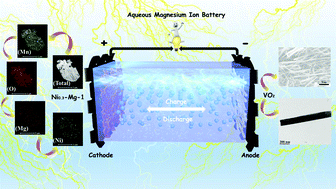Ni-Doped magnesium manganese oxide as a cathode and its application in aqueous magnesium-ion batteries with high rate performance†
Abstract
Aqueous magnesium-ion batteries feature good safety and high energy density and represent promising energy storage systems. However, optimized electrodes are the key to realize their advantages. In this work, we have reported a Ni-doped magnesium manganese oxide as the cathode via a conventional hydrothermal method, which can help improve conductivity and solve defects derived from pure manganese oxide with nickel doping. This electrode exhibited excellent cycle performance in an Mg(NO3)2 electrolyte, and the corresponding retention was 89.7% after 300 cycles. Moreover, using VO2 nanorods, generated via a one-step hydrothermal process, as the anode material revealed good rate properties. For example, this anode could deliver discharge capacities of 212.1, 169.6, 148.4, 88.2 and 45.4 mA h g−1 at 20, 50, 100, 200 and 500 mA g−1, respectively, from −0.8 V to 0 V. Moreover, this battery obtained an initial discharge capacity of 125.1 mA h g−1 at a current density of 100 mA g−1 and cycling stability with 86% capacity retention after 100 cycles. Therefore, the assembly of this aqueous magnesium-ion battery with excellent rate performance was based on two electrodes. In addition, the corresponding electrochemical reaction mechanism was explored.



 Please wait while we load your content...
Please wait while we load your content...